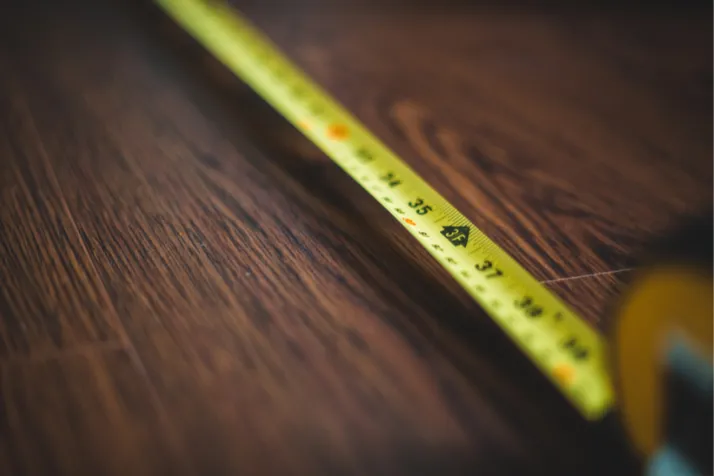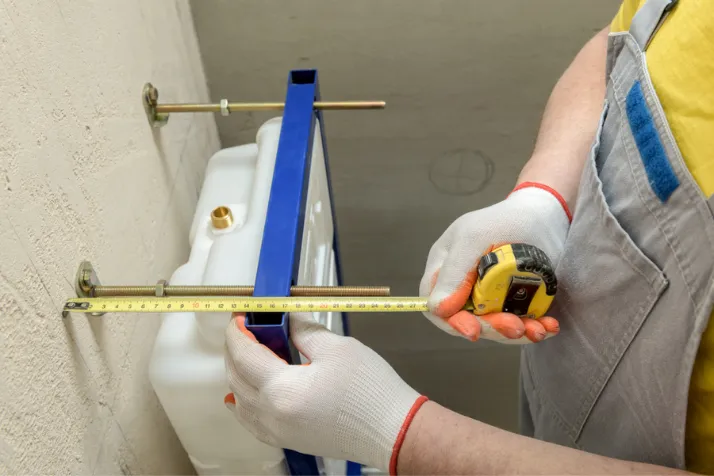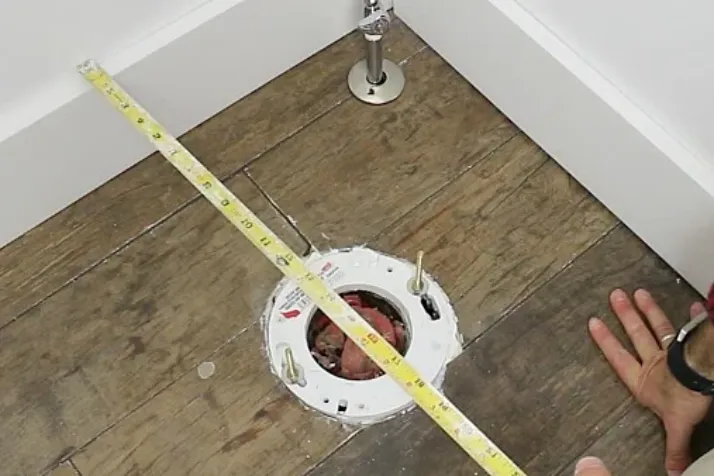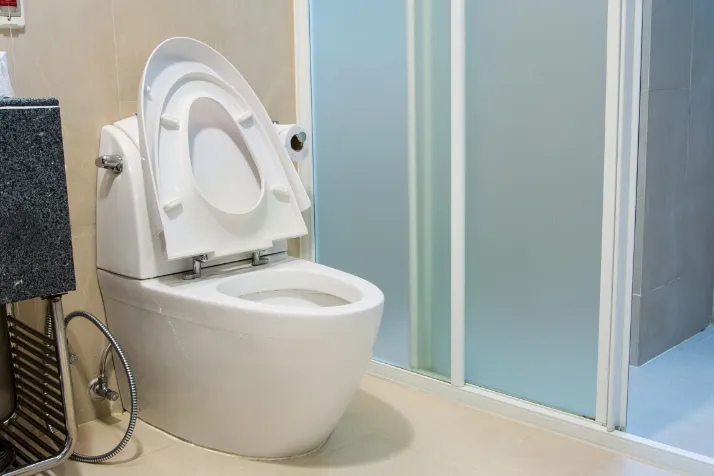Do you want to measure the exact toilet rough in dimensions?
If your toilet is giving you hard time and it has become quite old, it is the right time to get your hands on a new one because, with time, the performance also goes down.
However, before buying a new one, you have to be extra conscious about the dimensions because it is the most common mistake people do. Instead of calling someone, you can measure the toilet dimensions at home but how?
This is what we will discuss in this detailed guide. Let’s get started.
What are Toilet Rough-in Dimensions?
- Before jumping into the procedure, let’s first talk about this term so that you get a better idea. Whenever you are about to install a new toilet, your number 1 priority should be to measure the toilet rough in that the accurate size between the wall and the toilet drainpipe’s center.
- It is how you will never go wrong with your measurements. Even if you have zero knowledge, this guide will fully help you to learn how to take proper measurements.
- Along with that, you should also brace yourself for errors that people commonly make while taking measurements that result in wrong bathroom dimensions.
Tools and Materials Required
As it is DIY work so you should know what tools or materials you are going to use so that you can purchase them earlier. Ensure the tool you are using is flexible so that you do not face any difficulty while moving them.
For this purpose, get your hands on measuring tape that should be simple and loose. Various magnetic tapes are available that you can use. After getting this tape, do not forget to keep a pen and pencil so that you can note down the measurements of each side otherwise, you might forget them.
However, the tape you are using should be easily understandable so that you are not confused. You do not need any other tool in this regard.
Toilet Rough-in Measurement: A Step by Step Guide
Measuring the toilet rough-in dimensions is the simplest work for which you do not need anyone’s assistance. However, you should be careful throughout the process because one wrong reading can make the entire measurement messed up.
You have gotten your hands on the measuring tape, pen, and paper, let’s start with the process.
 Step 1. Taking Measurements without Toilet
Step 1. Taking Measurements without Toilet
If there is no toilet in the bathroom and you want to install a new one for which you need accurate measurements, follow the below steps. Without a toilet, it is easy to take measurements.
The steps include:
- Firstly, you have to take the measurements of the drainpipe (also known as toilet flange opening). The drain pipe resembles a hole cut that is coated with a white plastic lining.
- Now you have to measure the exact location from the wall to the center location of the drainpipe. If the wall contains a baseboard as well then do not forget to count it in your measurements.
- Now go through the measurements you have taken. The standard size is usually 10” or 12” rough in size. If your measurement exceeds this number, you are doing wrong. Take the measurements again according to the above-mentioned steps and keep repeating them until you are successful.
 Step 2. Measuring Standard Toilet Rough-in Sizes
Step 2. Measuring Standard Toilet Rough-in Sizes
It is not compulsory to take measurements when there is no toilet. You can also do this work in the presence of a toilet. For this purpose, follow the below steps and pay special consideration so that nothing goes wrong.
The steps are:
- Look for the caps and small bolts that are placed at the toilet’s base. If you are not familiar with where they locate, check the right and left sides of the fixture. If the design of your toilet is skirted, it might be bolted on one side of the toilet or at the point where it meets the floor. Get your hands on painter’s tape in order to know the exact location.
- Now you have to measure the rough-in distance of the toilet for which take the measuring tape and put it on the base floor and stretch it to the center of the base bolt of the toilet. Remember to stop stretching once you reach the center point.
- Like the above process, do not measure from the baseboard. If the walls contain baseboards, you have to carefully adjust the measuring tape as you have to take them from the bare walls instead of from the baseboards. However, if you want to count the baseboard’s measurement as well, take the width and then add it to the exact measurements. It will be appropriate.
- Once you are done, go through the work in order to know whether your work is correct or not. If the result comes either 10”, 12”, or 14”, you are good to go. However, if the number is other than these, remeasure it because you have done some mistake. This is the standard toilet height.
 Step 3. Measuring Corner Toilet Rough-in
Step 3. Measuring Corner Toilet Rough-in
Standard toilets and corner toilets are the two most common types that are found in every household. Instead of using standard toilets, if you want to take the dimension of corner toilets, the process is different.
They are thicker but you can easily take the measurements by following the below-mentioned points. Here we go.
- Look for the point where your corner toilet has been bolted. Check the bolts and caps so that you get an idea about the exact location where the toilet meets the floor.
- In order to find out the exact measurement of the toilet flange or drainpipe, you have to identify the location of the bolt. The corner toilets completely overtake toilet flange that’s why it is not possible to find out the exact location. The toilet flange usually lies between the two bolts at the counterpart.
- Now you have to measure the location of the toilet flange of your toilet. You can use a measuring tape or any tool that would be feasible for you in this regard. However, ensure to take the exact measurements. The toilet flange usually lies between the tank and the seat of the toilet.
- Put the measuring tape at the center of the flange and stretch it to the adjacent walls. In Corner toilets, you do not have to measure from the drain pipes like in standard toilets. Start measuring from the toilet flange at a 90-degree angle. If you want to take the exact angle, you can use a framing square and a measuring square.
Mistakes to Avoid while Toilet Rough-in Measurements
There are a few common mistakes that people usually make when they measure toilet rough-in dimensions because of a lack of experience. Let me discuss those errors so that you can avoid doing in the future. Those mistakes include:
- Do not start taking measurements from the baseboard that is found on the bathroom floor’s perimeter. If you are doing so, it can skew your measurements up to 1/2”. Hence, you should only start with toilet flange or drainpipes as already mentioned above.
- If the bolt cap is not located at the center of the discharge hole, do not measure it. Many people also assume that it is alleged at the center which is totally wrong. Avoid counting this bolt while taking the measurements.
- Another common mistake that people often make is wrongly measuring bigger toilet units. They think that the bigger toiler units need large rough measurements which is totally wrong.
If you avoid these mistakes, you can easily get your hands on to-the-point measurements that will help you complete the work quickly and easily. Hence, keep these above-mentioned points in mind to get rid of any future issues.
Measuring for the Water Supply Line
It is another important measurement that should be taken for the cold water supply line. If you want that your toilet gets a constant water supply, taking the right measurement is a must. For this purpose:
- Put the measuring tape on the center of the flange and stretch it to the left side of the toilet.
- From that point, again measure from the finished floor above 6 or 7 inches.
- Once you are done, mark the area so that it shows where the water supply line will be installed. Mark it with an X.
It is one of the easiest ways and the most crucial as well so do not take it lightly.
Choosing the Right Toilet
In choosing the right toilet, the most crucial step is to take the exact and correct rough measurements. A little mistake in the measurements will cost you later so do not take it for granted.
Apart from getting an appropriate measurement, you also have to consider the depth, height, width, and shape of your toilet bowl. If you go for a too large toilet, it will create different problems including difficulty in closing and opening the door.
Moreover, getting your hands on too wide a toilet is also not a suitable choice because it might be jammed between the shower, walls, and vanity. Remember that there should be at least 15″ of space between the toilet and other things so that there comes no hurdles or obstacles.
You do not have to worry about the bowl and toilet seat unless and until it lies between 17 and 19 however, when it comes to the toilet tank, stop and think twice. If you have placed cabinets behind the toilet, be cautious about the tank because it might create problems.
Avoid getting the tank that is too large otherwise, you won’t be able to flush it properly. These things make a huge difference so be cautious about each factor so that you get the right toilet for your bathroom.
FAQs – Frequently Asked Questions
The guide to standard toilet dimensions or toilet sizes is not ending here as we have to discuss some queries that people usually ask. Let’s have a look at those questions below.
What are the Rough Dimensions for a Toilet?
The toilet rough in dimension is the exact size between the wall and the toilet drainpipe’s center. The standard toilet rough in dimension is said to be 12 inches but it can also lie in between 10 to 14 inches.
It is important to get an accurate measurement if you want no issues while installing a new toilet in your bathroom.
How Do I Know if My Toilet is a 10 or 12 Rough?
With the measuring tape, you can figure out the accurate rough size. If your toilet consists of 4 bolts, place the measuring tape at the center of the rear bolts and stretch it to the walls. Detailed information on how to take the measurement is already mentioned above.
How Far from the Wall Should a Toilet Rough-in Be?
The size of the standard drywall is at least 1/2 inch so there should be a distance of 15-1/2 inches from the flange’s center to the wall framing. The plumber should keep this point in mind so that he maintains the appropriate distance.
If you are doing DIY work, keep this point in mind.
Are All Toilets the Same Distance from the Wall?
Remember that you always have to start measuring the distance from the bowl’s center. Get your hands on the best measuring tape where taking readings is easy for you.
Normally, the distance between the toilet and other accessories including the shower, side wall, and tub is 15 inches.
Final Thoughts
You might be wondering that taking the exact rough measurements is complicated but once you brace yourself with the real concept of taking the right and accurate measurements, it will no longer be difficult for you.
If you don’t have enough time or you are unaware of anything, you can call a plumber who will demand a heavy amount for this work depending on the complexity of the job.
However, if you are interested in learning something new and have enough time for this work, I would recommend you do this DIY work so that you can save on plumber costs.

 Step 1. Taking Measurements without Toilet
Step 1. Taking Measurements without Toilet
 Step 2. Measuring Standard Toilet Rough-in Sizes
Step 2. Measuring Standard Toilet Rough-in Sizes
 Step 3. Measuring Corner Toilet Rough-in
Step 3. Measuring Corner Toilet Rough-in

Leave a Reply